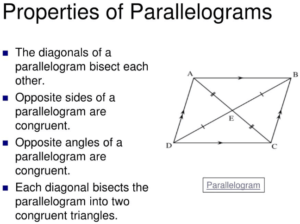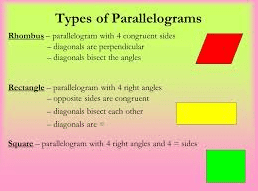Types of Parallelogram and its Properties

A parallelogram is a polygon with four sides ( quadrilateral ) being equal and parallel two to two.
Parts of Parallelogram
- Sides: The parallelogram has four sides, two to two being equal and parallel ( a and b ).
- Angles: interior angles are equal to two to two, non-consecutive angles (α and β) being equal. As in any quadrilateral, its interior angles add up to 360° (2 α + 2 β = 360°).
- Diagonals: in the event that the diagonals ( D 1 and D 2 ) are perpendicular, the parallelogram will be a square or a rhombus. If the diagonals are equal, it is a square or a rectangle. Its two diagonals can be calculated using the parallelogram law.
Parallelogram’s Shape
A parallelogram is a shape that has two dimensions. It has four sides, two of which are parallel. The parallel sides are also the same length. The form is not a parallelogram if the lengths of the parallel sides are not equal in measurement. Similarly, the parallelogram’s opposite inner angles should always be equal. It isn’t a parallelogram otherwise.

Types of parallelogram
Parallelograms are classified into four classes:
- Square: quadrilateral whose sides and angles are equal.
- Rectangle: it has four equal angles (90º) and equal sides two by two, the adjacent sides being different.
- Rhombus: all the sides are equal but the angles are different two by two so that the adjacent angles are different and each angle is equal to the non-adjacent angle.
- Rhomboid: has its sides and angles equal two to two. The rhomboid is also called a nonregular parallelogram.
Parallelogram Properties
A Parallelogram is a particular polygon formed by a quadrilateral with two parallel opposing sides. A parallelogram’s attributes are as follows:
- The opposing sides are congruent and parallel.
- The opposing angles are similar.
- The angles that follow are supplemental.
- If one of the angles is a right angle, then all of the others will be as well.
- The two diagonals cut each other in half.
- The parallelogram is divided into two congruent triangles by each diagonal.
- The total of the squares of a parallelogram’s diagonals equals the sum of the squares of all its sides. It’s also known as the parallelogram law.
How to find Area of Parallelogram?
A parallelogram’s area is the area it takes up in a two-dimensional plane. The formula for calculating the area of a parallelogram is as follows:
Area = Base x Altitude
How to find the Perimeter of Parallelogram?
The whole distance traveled around a shape, or its complete length is its perimeter. The perimeter of a parallelogram is the total distance between the parallelogram’s boundaries. To compute the perimeter value, we must first determine the length and width of the object. The opposite sides of a parallelogram are the same length. As a result, the formula for calculating the perimeter is as follows:
2 (a+b) units = Perimeter
Where a and b are the lengths of the parallelogram’s sides.
Angles of Parallelogram
A parallelogram is a two-dimensional shape with four angles that is flat and rectangular. Interior angles on both sides are the same. The supplementary angles on the same side of the transversal add up to 180 degrees. As a result, the total of a parallelogram’s internal angles equals 360°.
Related Articles: